Enabling Exploratory Yet Systematic Investigation of Presence Factors in Virtual Reality: Proposed Methodology, Research Tool Development, and Practical Application
Abstract
:1. Introduction
Motivation
2. Presence Factors in IVR: State of Research
2.1. Display Fidelity
2.2. User Characteristics
3. VR Study Tools: State-of-the-Art
4. Research Methodology
4.1. Exploratory Assessment of Preferred Configurations of Presence Factors
4.2. Confirmatory Study on the Combined Influence of Presence Factors
5. IVR Study Tool Development
5.1. IVR Application
5.1.1. Base System
5.1.2. IVR Scenarios
5.2. Experimenter Interface
5.2.1. UI and Study Modes
5.2.2. Communication Between Interface and IVR Application
6. Evaluation and Practical Application
6.1. Formative Expert Evaluation
6.1.1. Method
6.1.2. Results
Semi-Structured Interviews
Questionnaires
6.2. Conduction of Exploratory IVR Studies in the Context of a Research Project
6.2.1. Method
6.2.2. Results
Frequently Encountered Problems
Configuration of IV for Optimal Presence
7. Discussion
8. Conclusions
9. Limitations
Author Contributions
Funding
Institutional Review Board Statement
Informed Consent Statement
Data Availability Statement
Acknowledgments
Conflicts of Interest
Abbreviations
| AD | Adaptation dimension(s) |
| CAVE | Cave Automatic Virtual Environment |
| HCI | Human–Computer Interaction |
| HMD | Head-Mounted Display |
| IPQ | IGroup Presence Questionnaire |
| IV | Independent Variable(s) |
| IVE | Immersive Virtual Environment(s) |
| IVR | Immersive Virtual Reality |
| MPS | Multimodal Presence Scale |
| PQ | Witmer-Singer Presence Questionnaire |
| SUS | Slater–Usoh–Steed Presence Questionnaire |
Appendix A
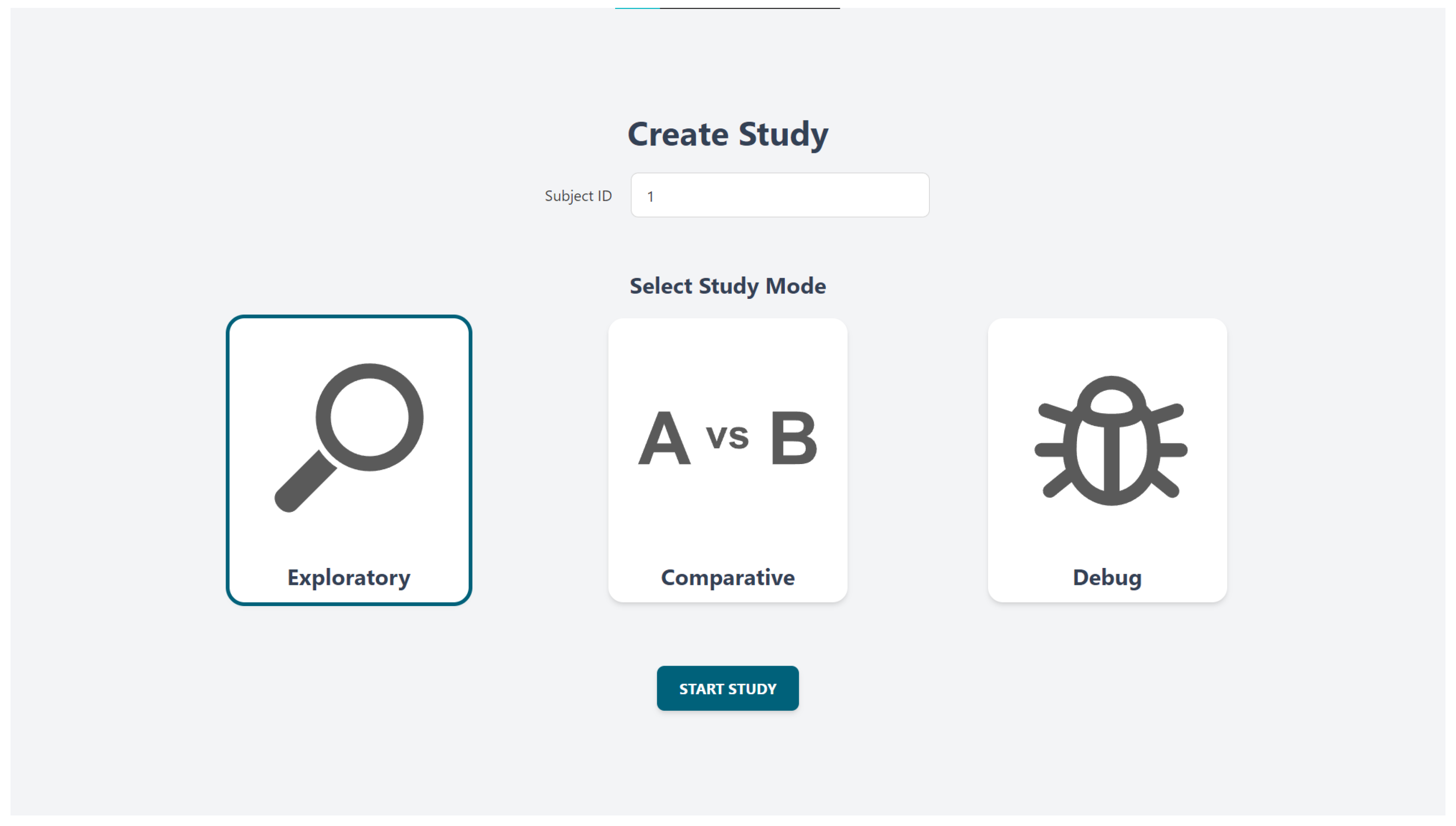
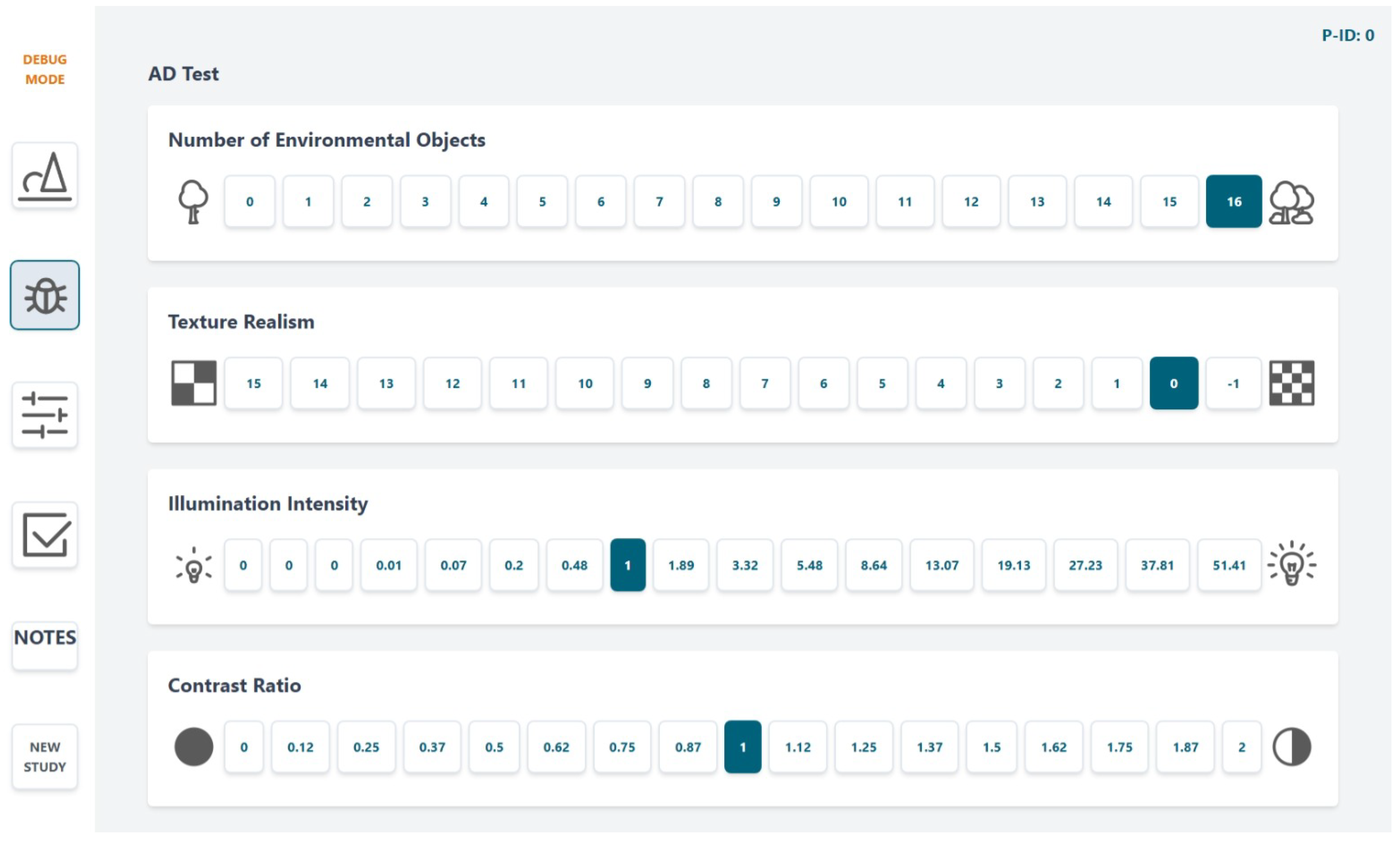
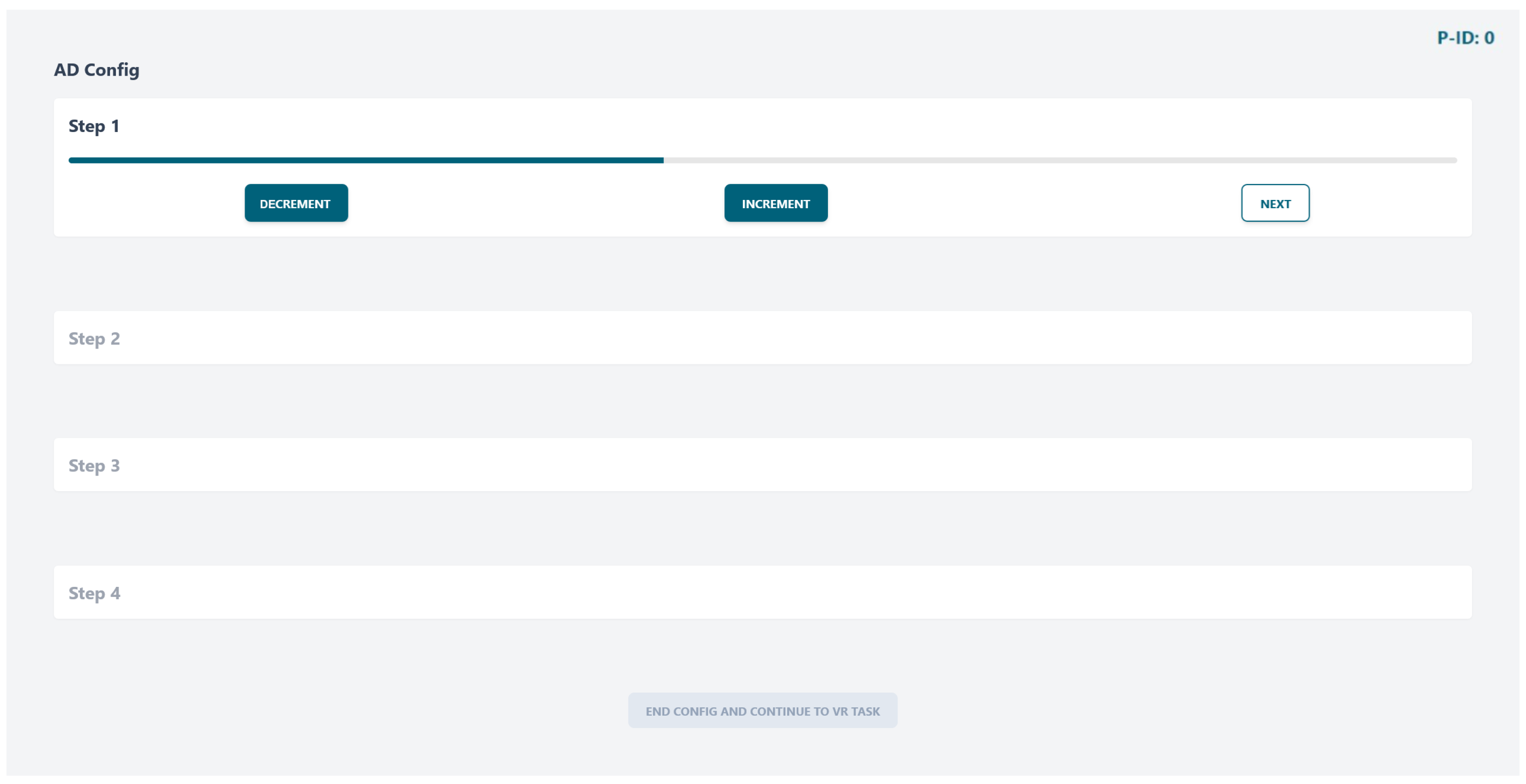
Appendix B
| Item Name | Item Text |
|---|---|
| In the computer-generated virtual environment … | |
| general presence (GP) | … I had a sense of “being there” |
| plausibility illusion (PSI) | … I had the feeling, that what was apparently happening was really happening. |
| involvement (INV) | … my attention was completely captivated. |
| physical/spatial presence (PP) | … the objects and rooms felt like real (material) things. |
| social presence (SoP) | … the people and animals seemed to me like living beings (with consciousness and feelings). |
| self-presence (SeP) | … I felt as if my virtual body was my real body. |
References
- Abeele, V.V.; Schraepen, B.; Huygelier, H.; Gillebert, C.; Gerling, K.; Van Ee, R. Immersive Virtual Reality for Older Adults: Empirically Grounded Design Guidelines. ACM Trans. Access. Comput. (TACCESS) 2021, 14, 1–30. [Google Scholar] [CrossRef]
- McGlynn, S.A.; Rogers, W.A. Design recommendations to enhance virtual reality presence for older adults. In Proceedings of the Human Factors and Ergonomics Society Annual Meeting, Wollongong, Australia, 26–29 November 2017; SAGE Publications: Los Angeles, CA, USA, 2017; Volume 61, pp. 2077–2081. [Google Scholar]
- Cummings, J.J.; Bailenson, J.N. How Immersive Is Enough? A Meta-Analysis of the Effect of Immersive Technology on User Presence. Media Psychol. 2016, 19, 272–309. [Google Scholar] [CrossRef]
- Coelho, C.; Tichon, J.; Hine, T.J.; Wallis, G.; Riva, G. Media presence and inner presence: The sense of presence in virtual reality technologies. In From Communication to Presence: Cognition, Emotions and Culture Towards the Ultimate Communicative Experience; IOS Press: Amsterdam, The Netherlands, 2006; Volume 11, pp. 25–45. [Google Scholar]
- Skarbez, R.; Brooks, F.P., Jr.; Whitton, M.C. A survey of presence and related concepts. ACM Comput. Surv. (CSUR) 2017, 50, 1–39. [Google Scholar] [CrossRef]
- Slater, M.; Wilbur, S. A framework for immersive virtual environments (FIVE): Speculations on the role of presence in virtual environments. Presence Teleoperators Virtual Environ. 1997, 6, 603–616. [Google Scholar] [CrossRef]
- Heeter, C. Being there: The subjective experience of presence. Presence Teleoperators Virtual Environ. 1992, 1, 262–271. [Google Scholar] [CrossRef]
- Schubert, T.; Friedmann, F.; Regenbrecht, H. The Experience of Presence: Factor Analytic Insights. Presence Teleoperators Virtual Environ. 2001, 10, 266–281. [Google Scholar] [CrossRef]
- Lee, K.M. Presence, explicated. Commun. Theory 2004, 14, 27–50. [Google Scholar] [CrossRef]
- Witmer, B.G.; Jerome, C.J.; Singer, M.J. The factor structure of the presence questionnaire. Presence Teleoperators Virtual Environ. 2005, 14, 298–312. [Google Scholar] [CrossRef]
- Slater, M. Place illusion and plausibility can lead to realistic behaviour in immersive virtual environments. Philos. Trans. R. Soc. B Biol. Sci. 2009, 364, 3549–3557. [Google Scholar] [CrossRef]
- Usoh, M.; Catena, E.; Arman, S.; Slater, M. Using presence questionnaires in reality. Presence 2000, 9, 497–503. [Google Scholar] [CrossRef]
- Makransky, G.; Lilleholt, L.; Aaby, A. Development and validation of the Multimodal Presence Scale for virtual reality environments: A confirmatory factor analysis and item response theory approach. Comput. Hum. Behav. 2017, 72, 276–285. [Google Scholar] [CrossRef]
- Souza, V.; Maciel, A.; Nedel, L.; Kopper, R. Measuring Presence in Virtual Environments: A Survey. ACM Comput. Surv. 2022, 54, 1–37. [Google Scholar] [CrossRef]
- Schuemie, M.J.; Van der Straaten, P.; Krijn, M.; Van der Mast, C.A. Research on presence in virtual reality: A survey. Cyberpsychology Behav. 2001, 4, 183–201. [Google Scholar] [CrossRef] [PubMed]
- Insko, B.E. Measuring Presence: Subjective, Behavioral and Physiological Methods. In Being There: Concepts, Effects and Measurements of User Presence in Synthetic Environments; Riva, G., Davide, F., IJsselsteijn, W.A., Eds.; Ios Press: Amsterdam, The Netherlands, 2003. [Google Scholar]
- Slater, M. How colorful was your day? Why questionnaires cannot assess presence in virtual environments. Presence 2004, 13, 484–493. [Google Scholar] [CrossRef]
- Felton, W.M.; Jackson, R.E. Presence: A Review. Int. J. -Hum.-Comput. Interact. 2021, 38, 1–18. [Google Scholar] [CrossRef]
- North, M.M.; North, S. A Comparative Study of Sense of Presence of Traditional Virtual Reality and Immersive Environments. Australas. J. Inf. Syst. 2016, 20, 1–16. [Google Scholar]
- Christofi, M.; Baka, E.; Stavroulia, K.; Michael-Grigoriou, D.; Lanitis, A.; Thalmann, N.M. Studying Levels of Presence in a Virtual Environment Simulating Drug Use in Schools: Effect on Different Character Perspectives. In Proceedings of the ICAT-EGVE 2018—28th International Conference on Artificial Reality and Telexistence and 23rd Eurographics Symposium on Virtual Environments, Limassol, Cyprus, 7–9 November 2018; pp. 163–170. [Google Scholar] [CrossRef]
- Eckstein, B.; Krapp, E.; Elsässer, A.; Lugrin, B. Smart substitutional reality: Integrating the smart home into virtual reality. Entertain. Comput. 2019, 31, 100306. [Google Scholar] [CrossRef]
- Bozgeyikli, E.; Raij, A.; Katkoori, S.; Dubey, R. Point & teleport locomotion technique for virtual reality. In Proceedings of the 2016 Annual Symposium on Computer-Human Interaction in Play, Austin, TX, USA, 16–19 October 2016; pp. 205–216. [Google Scholar]
- Chessa, M.; Maiello, G.; Borsari, A.; Bex, P.J. The Perceptual Quality of the Oculus Rift for Immersive Virtual Reality. Hum. Comput. Interact. 2019, 34, 51–82. [Google Scholar] [CrossRef]
- Carter, L.; Potter, L.E. Designing games for presence in consumer virtual reality. In Proceedings of the 2016 ACM SIGMIS Conference on Computers and People Research, Alexandria, VA, USA, 2–4 June 2016; pp. 141–148. [Google Scholar] [CrossRef]
- Rhiu, I.; Kim, Y.M.; Kim, W.; Yun, M.H. The evaluation of user experience of a human walking and a driving simulation in the virtual reality. Int. J. Ind. Ergon. 2020, 79, 103002. [Google Scholar] [CrossRef]
- Puri, A.; Baker, S.; Hoang, T.N.; Zuffi, R.C. To be (Me) or not to be? photorealistic avatars and older adults. ACM Int. Conf. Proceeding Ser. 2017, 503–507. [Google Scholar] [CrossRef]
- Slater, M.; Spanlang, B.; Corominas, D. Simulating virtual environments within virtual environments as the basis for a psychophysics of presence. ACM Trans. Graph. (TOG) 2010, 29, 1–9. [Google Scholar] [CrossRef]
- Dresel, M.; Plaumann, J.; Jochems, N. Investigating Age Differences in Passive Haptic Feedback for Immersive Virtual Reality: A Pilot Study on Configuration Tasks. In Proceedings of the International Conference on Extended Reality; Springer: Berlin/Heidelberg, Germany, 2023; pp. 210–222. [Google Scholar]
- Volkmann, T.; Wessel, D.; Franke, T.; Jochems, N. Testing the Social Presence Aspect of the Multimodal Presence Scale in a Virtual Reality Game. In Proceedings of the Mensch und Computer 2019, Hamburg, Germany, 8–11 September 2019; pp. 433–437. [Google Scholar] [CrossRef]
- Schwind, V.; Knierim, P.; Haas, N.; Henze, N. Using presence questionnaires in virtual reality. In Proceedings of the 2019 CHI Conference on Human Factors in Computing Systems, Scotland, UK, 4–9 May 2019; pp. 1–12. [Google Scholar]
- Putze, S.; Alexandrovsky, D.; Putze, F.; Höffner, S.; Smeddinck, J.D.; Malaka, R. Breaking The Experience: Effects of Questionnaires in VR User Studies. In Proceedings of the 2020 CHI Conference on Human Factors in Computing Systems, Honolulu, HI, USA, 25–30 April 2020. [Google Scholar] [CrossRef]
- Baños, R.M.; Botella, C.; Rubió, I.; Quero, S.; García-Palacios, A.; Alcañiz, M. Presence and emotions in virtual environments: The influence of stereoscopy. Cyberpsychology Behav. 2008, 11, 1–8. [Google Scholar] [CrossRef] [PubMed]
- Grassini, S.; Laumann, K.; Luzi, A.K. Association of individual factors with simulator sickness and sense of presence in virtual reality mediated by head-mounted displays (Hmds). Multimodal Technol. Interact. 2021, 5, 7. [Google Scholar] [CrossRef]
- Tanja-Dijkstra, K.; Pahl, S.; White, M.P.; Auvray, M.; Stone, R.J.; Andrade, J.; May, J.; Mills, I.; Moles, D.R. The soothing sea: A virtual coastal walk can reduce experienced and recollected pain. Environ. Behav. 2018, 50, 599–625. [Google Scholar] [CrossRef]
- Chirico, A.; Ferrise, F.; Cordella, L.; Gaggioli, A. Designing awe in virtual reality: An experimental study. Front. Psychol. 2018, 8, 2351. [Google Scholar] [CrossRef]
- Brennan, P.F.; Nicolalde, F.D.; Ponto, K.; Kinneberg, M.; Freese, V.; Paz, D. Cultivating imagination development and pilot test of a therapeutic use of an immersive virtual reality CAVE. Am. Med. Inform. Assoc. (AMIA) Annu. Symp. Proc. 2013, 2013, 135–144. [Google Scholar]
- Corriveau Lecavalier, N.; Ouellet, É.; Boller, B.; Belleville, S. Use of immersive virtual reality to assess episodic memory: A validation study in older adults. Neuropsychol. Rehabil. 2020, 30, 462–480. [Google Scholar] [CrossRef]
- Schuemie, M.J.; Abel, B.; Van Der Mast, C.A.; Krijn, M.; Emmelkamp, P.M. The effect of locomotion technique on presence, fear and usability in a virtual environment. In Proceedings of the EUROMEDIA 2005—11th Annual Scientific Conference on Web Technology, New Media Communications and Telematics Theory Methods, Tools and Applications, London, UK, 21–23 September 2005; pp. 129–135. [Google Scholar]
- Bangay, S.; Preston, L. An investigation into factors influencing immersion in interactive virtual reality environments. Stud. Health Technol. Inform. 1998, 58, 43–51. [Google Scholar] [CrossRef]
- Berndt, H.; Wessel, D.; Willer, L.; Herczeg, M.; Mentler, T. Immersion and presence in virtual reality training for mass casualty incidents. In Proceedings of the International ISCRAM Conference, Rochester, NY, USA, 20–23 May 2018; pp. 797–805. [Google Scholar]
- Born, F.; Masuch, M.; Hahn, A. Ghost sweeper: Using a heavy passive haptic controller to enhance a room-scale vr exergame. In Proceedings of the 2020 IEEE Conference on Games (CoG), Osaka, Japan, 24–27 August 2020; pp. 221–228. [Google Scholar]
- Botella, C.; Rey, A.; Perpiñá, C.; Baños, R.; Alcaniz, M.; García-Palacios, A.; Villa, H.; Alozano, J. Differences on Presence and Reality Judgement Using a High Impact Workstation and a PC Workstation. Cyberpsychology Behav. 1999, 2, 49–52. [Google Scholar] [CrossRef]
- Cmentowski, S.; Krekhov, A.; Krüger, J. Outstanding: A multi-perspective travel approach for virtual reality games. In Proceedings of the Annual Symposium on Computer-Human Interaction in Play, Barcelona, Spain, 22–25 October 2019; pp. 287–299. [Google Scholar]
- Kritikos, J.; Zoitaki, C.; Tzannetos, G.; Mehmeti, A. Comparison between Full Body Motion Recognition Camera Interaction and Hand Controllers Interaction used in Virtual Reality Exposure Therapy for Acrophobia. Sensors 2020, 20, 1244. [Google Scholar] [CrossRef]
- Grabowski, A.; Jankowski, J. Virtual reality-based pilot training for underground coal miners. Saf. Sci. 2015, 72, 310–314. [Google Scholar] [CrossRef]
- Wölfel, M.; Hepperle, D.; Purps, C.F.; Deuchler, J.; Hettmann, W. Entering a new dimension in virtual reality research: An overview of existing toolkits, their features and challenges. In Proceedings of the 2021 International Conference on Cyberworlds (CW), Caen, France, 28–30 September 2021; pp. 180–187. [Google Scholar]
- McMahan, R.P.; Bowman, D.A.; Zielinski, D.J.; Brady, R.B. Evaluating display fidelity and interaction fidelity in a virtual reality game. IEEE Trans. Vis. Comput. Graph. 2012, 18, 626–633. [Google Scholar] [CrossRef] [PubMed]
- Mania, K.; Chalmers, A. The effects of levels of immersion on memory and presence in virtual environments: A reality centered approach. Cyberpsychology Behav. 2001, 4, 247–264. [Google Scholar] [CrossRef] [PubMed]
- Makransky, G.; Wismer, P.; Mayer, R.E. A gender matching effect in learning with pedagogical agents in an immersive virtual reality science simulation. J. Comput. Assist. Learn. 2019, 35, 349–358. [Google Scholar] [CrossRef]
- Slater, M.; Usoh, M.; Steed, A. Depth of presence in virtual environments. Presence Teleoperators Virtual Environ. 1994, 3, 130–144. [Google Scholar] [CrossRef]
- Zielasko, D.; Weyers, B.; Kuhlen, T.W. Travel your desk? An office desk substitution and its effects on cybersickness, presence and performance in an hmd-based exploratory analysis task. In Proceedings of the 26th IEEE Conference on Virtual Reality and 3D User Interfaces, VR 2019, Osaka, Japan, 23–27 March 2019; pp. 1285–1286. [Google Scholar] [CrossRef]
- Steinicke, F.; Bruder, G.; Hinrichs, K.; Lappe, M.; Ries, B.; Interrante, V. Transitional environments enhance distance perception in immersive virtual reality systems. In Proceedings of the 6th Symposium on Applied Perception in Graphics and Visualization, Chania, Greece, 30 September–2 October 2009; pp. 19–26. [Google Scholar]
- Fribourg, R.; Argelaguet, F.; Hoyet, L.; Lecuyer, A. Studying the Sense of Embodiment in VR Shared Experiences. In Proceedings of the 25th IEEE Conference on Virtual Reality and 3D User Interfaces, VR 2018, Tuebingen/Reutlingen, Germany, 18–22 March 2018; pp. 273–280. [Google Scholar] [CrossRef]
- Llorach, G.; Evans, A.; Blat, J. Simulator sickness and presence using HMDs: Comparing use of a game controller and a position estimation system. In Proceedings of the ACM Symposium on Virtual Reality Software and Technology, VRST, Edinburgh, Scotland, 11–13 November 2014; pp. 137–140. [Google Scholar] [CrossRef]
- McMahan, R.P. Exploring the effects of higher-fidelity display and interaction for virtual reality games. Ph.D. Thesis, Virginia Tech, Blacksburg, Virginia, 2011. [Google Scholar]
- Bowman, D.A.; McMahan, R.P. Virtual reality: How much immersion is enough? Computer 2007, 40, 36–43. [Google Scholar] [CrossRef]
- Nikolic, D. Evaluating Relative Impact of Virtual Reality Components Detail and Realism on Spatial Comprehension and Presence. Doctoral Dissertation, Pennsylvania State University, University Park, PA, USA, 2007. [Google Scholar]
- Slater, M.; Khanna, P.; Mortensen, J.; Yu, I. Visual realism enhances realistic response in an immersive virtual environment. IEEE Comput. Graph. Appl. 2009, 29, 76–84. [Google Scholar] [CrossRef]
- Khanna, P.; Yu, I.; Mortensen, J.; Slater, M. Presence in response to dynamic visual realism: A preliminary report of an experiment study. In Proceedings of the ACM Symposium on Virtual Reality Software and Technology, Monterey, CA, USA, 1–3 November 2006; pp. 364–367. [Google Scholar]
- Yu, I.; Mortensen, J.; Khanna, P.; Spanlang, B.; Slater, M. Visual realism enhances realistic response in an immersive virtual environment-part 2. IEEE Comput. Graph. Appl. 2012, 32, 36–45. [Google Scholar] [CrossRef]
- Welch, R.B.; Blackmon, T.T.; Liu, A.; Mellers, B.A.; Stark, L.W. The effects of pictorial realism, delay of visual feedback, and observer interactivity on the subjective sense of presence. Presence Teleoperators Virtual Environ. 1996, 5, 263–273. [Google Scholar] [CrossRef]
- Hvass, J.S.; Larsen, O.; Vendelbo, K.B.; Nilsson, N.C.; Nordahl, R.; Serafin, S. The effect of geometric realism on presence in a virtual reality game. In Proceedings of the 2017 IEEE Virtual Reality, Los Angeles, CA, USA, 18–22 March 2017; pp. 339–340. [Google Scholar] [CrossRef]
- Gromer, D.; Reinke, M.; Christner, I.; Pauli, P. Causal interactive links between presence and fear in virtual reality height exposure. Front. Psychol. 2019, 10, 141. [Google Scholar] [CrossRef]
- Zimmons, P.; Panter, A. The influence of rendering quality on presence and task performance in a virtual environment. In Proceedings of the IEEE Virtual Reality, Los Angeles, CA, USA, 22–26 March 2003; pp. 293–294. [Google Scholar] [CrossRef]
- Phillips, L.; Interrante, V.; Kaeding, M.; Ries, B.; Anderson, L. A further assessment of factors correlating with presence in immersive virtual environments. In Proceedings of the JVRC10: Joint Virtual Reality Conference of EGVE, EuroVR, VECs, Stuttgart, Germany, 27 September–1 October 2010; pp. 55–63. [Google Scholar] [CrossRef]
- Higuera-Trujillo, J.L.; López-Tarruella Maldonado, J.; Llinares Millán, C. Psychological and physiological human responses to simulated and real environments: A comparison between Photographs, 360∘ Panoramas, and Virtual Reality. Appl. Ergon. 2017, 65, 398–409. [Google Scholar] [CrossRef] [PubMed]
- Rand, D.; Kizony, R.; Feintuch, U.; Katz, N.; Josman, N.; Rizzo, A.; Weiss, P.L. Comparison of two VR platforms for rehabilitation: Video capture versus HMD. Presence Teleoperators Virtual Environ. 2005, 14, 147–160. [Google Scholar] [CrossRef]
- Felnhofer, A.; Kothgassner, O.D.; Hauk, N.; Beutl, L.; Hlavacs, H.; Kryspin-Exner, I. Physical and social presence in collaborative virtual environments: Exploring age and gender differences with respect to empathy. Comput. Hum. Behav. 2014, 31, 272–279. [Google Scholar] [CrossRef]
- McGlynn, S.A. Investigating Age-Related Differences in Spatial Presence Formation and Maintenance in Virtual Reality. Ph.D. Thesis, Georgia Institute of Technology, Atlanta, GA, USA, 2019. [Google Scholar]
- Janeh, O.; Bruder, G.; Steinicke, F.; Gulberti, A.; Poetter-Nerger, M. Analyses of Gait Parameters of Younger and Older Adults during (Non-)Isometric Virtual Walking. IEEE Trans. Vis. Comput. Graph. 2018, 24, 2663–2674. [Google Scholar] [CrossRef]
- Laarni, J.; Ravaja, N.; Saari, T.; Hartmann, T. Personality-related differences in subjective presence. In Proceedings of the Seventh Annual International Workshop Presence, Valencia, Spain, 13–15 October 2004; pp. 88–95. [Google Scholar]
- Jurnet, I.A.; Beciu, C.C.; Maldonado, J.G. Individual differences in the sense of presence. Proc. Presence 2005, 133–142. [Google Scholar]
- Jurnet, I.A.; Gutiérrez-Maldonado, J. Influence of personality and individual abilities on the sense of presence experienced in anxiety triggering virtual environments. Int. J. Hum. Comput. Stud. 2010, 68, 788–801. [Google Scholar] [CrossRef]
- Dewez, D.; Fribourg, R.; Sanz, F.A.; Hoyet, L.; Mestre, D.; Slater, M.; Lécuyer, A.; Dewez, D.; Fribourg, R.; Sanz, F.A.; et al. Influence of Personality Traits and Body Awareness on the Sense of Embodiment in Virtual Reality To cite this version: HAL Id: Hal-02385783 Influence of Personality Traits and Body Awareness on the Sense of Embodiment in Virtual Reality. In Proceedings of the 2019 IEEE International Symposium on Mixed and Augmented Reality, Beijing, China, 14–18 October 2019. [Google Scholar]
- Brade, J.; Lorenz, M.; Busch, M.; Hammer, N.; Tscheligi, M.; Klimant, P. Being there again—Presence in real and virtual environments and its relation to usability and user experience using a mobile navigation task. Int. J. Hum. Comput. Stud. 2017, 101, 76–87. [Google Scholar] [CrossRef]
- Coxon, M.; Kelly, N.; Page, S. Individual differences in virtual reality: Are spatial presence and spatial ability linked? Virtual Real. 2016, 20, 203–212. [Google Scholar] [CrossRef]
- Phillips, L.; Interrante, V.; Kaeding, M.; Ries, B.; Anderson, L. Correlations between physiological response, gait, personality, and presence in immersive virtual environments. Presence Teleoperators Virtual Environ. 2012, 21, 119–141. [Google Scholar] [CrossRef]
- Usoh, M.; Arthur, K.; Whitton, M.C.; Bastos, R.; Steed, A.; Slater, M.; Brooks, F.P. Walking > walking-in-place > flying, in virtual environments. In Proceedings of the 26th Annual Conference on Computer Graphics and Interactive Techniques, SIGGRAPH 1999, Los Angeles, CA, USA, 8–13 August 1999; pp. 359–364. [Google Scholar] [CrossRef]
- Shi, Y.; Du, J.; Ragan, E.; Choi, K.; Ma, S. Social Influence on Construction Safety Behaviors: A Multi-user Virtual Reality Experiment. In Proceedings of the Construction Research Congress 2018, New Orleans, Louisiana, 2–4 April 2018. [Google Scholar]
- Li, S.; Gu, X.; Yi, K.; Yang, Y.; Wang, G.; Manocha, D. Self-Illusion: A Study on High-Level Cognition of Role-Playing in Immersive Virtual Environments from Non-Human Perspective. IEEE Trans. Vis. Comput. Graph. 2020, 28, 3035–3049. [Google Scholar] [CrossRef]
- Gall, D.; Latoschik, M.E. The Effect of Haptic Prediction Accuracy on Presence. In Proceedings of the 25th IEEE Conference on Virtual Reality and 3D User Interfaces, Reutlingen, Germany, 18–22 March 2018; pp. 73–80. [Google Scholar] [CrossRef]
- Gamelin, G.; Chellali, A.; Cheikh, S.; Ricca, A.; Dumas, C.; Otmane, S. Point-cloud avatars to improve spatial communication in immersive collaborative virtual environments. Pers. Ubiquitous Comput. 2021, 25, 467–484. [Google Scholar] [CrossRef]
- Volkmann, T.; Wessel, D.; Caliebe, T.O.; Jochems, N. What you see isn’t necessarily what you get: Testing the influence of polygon count on physical and self-presence in virtual environments. In Proceedings of the Mensch und Computer 2020, Magdeburg, Germany, 6–9 September 2020; pp. 119–128. [Google Scholar]
- Thai, K.T.P.; Jung, S.; Lindeman, R.W. On the use of ”Active Breaks” to perform Eye Exercises for more Comfortable VR Experiences. In Proceedings of the 2020 IEEE Conference on Virtual Reality and 3D User Interfaces, VRW 2020, Atlanta, GA, USA, 22–26 March 2020; pp. 455–459. [Google Scholar] [CrossRef]
- Born, F.; Masuch, M. Increasing presence in a mixed reality application by integrating a real time tracked full body representation. In Proceedings of the International Conference on Advances in Computer Entertainment, Osaka, Japan, 9–12 November 2018; pp. 46–60. [Google Scholar] [CrossRef]
- Freiwald, J.P.; Ariza, O.; Janeh, O.; Steinicke, F. Walking by Cycling: A Novel In-Place Locomotion User Interface for Seated Virtual Reality Experiences. In Proceedings of the 2020 CHI Conference on Human Factors in Computing Systems, Honolulu, HI, USA, 25–30 April 2020; pp. 1–12. [Google Scholar] [CrossRef]
- Dresel, M.; Jochems, N. A Distributed Virtual Reality Study under COVID-19 Conditions Comparing Continuous and Non-Continuous Locomotion Techniques in Mobile VR. Mensch Comput. 2021, 406–411. [Google Scholar] [CrossRef]
- Jung, S.; Wisniewski, P.J.; Sandor, C.; Hughes, C.E. RealME: The influence of body and hand representations on body ownership and presence. In Proceedings of the 5th Symposium on Spatial User Interaction, Brighton, UK, 16–17 October 2017; pp. 3–11. [Google Scholar] [CrossRef]
- Parger, M.; Schmalstieg, D.; Mueller, J.H.; Steinberger, M. Human upper-body inverse kinematics for increased embodiment in consumer-grade virtual reality. In Proceedings of the ACM Symposium on Virtual Reality Software and Technology, VRST, Tokyo, Japan, 28 November–1 December 2018. [Google Scholar] [CrossRef]
- Athif, M.; Rathnayake, B.L.; Nagahapitiya, S.M.; Samarasinghe, S.A.; Samaratunga, P.S.; Peiris, R.L.; De Silva, A.C. Using Biosignals for Objective Measurement of Presence in Virtual Reality Environments. In Proceedings of the Annual International Conference of the IEEE Engineering in Medicine and Biology Society, Montreal, QC, Canada, 20–24 July 2020; pp. 3035–3039. [Google Scholar] [CrossRef]
- Brade, J.; Kögel, A.; Fuchs, C.; Klimant, P. Impact of First Person Avatar Representation in Assembly Simulations on Perceived Presence and Acceptance. In Proceedings of the VISIGRAPP (1: GRAPP), Valletta, Malta, 27–29 February 2020; pp. 17–24. [Google Scholar]
- Buttussi, F.; Chittaro, L. Effects of Different Types of Virtual Reality Display on Presence and Learning in a Safety Training Scenario. IEEE Trans. Vis. Comput. Graph. 2018, 24, 1063–1076. [Google Scholar] [CrossRef] [PubMed]
- Huang, W. Exploring players’ user experience in a high-embodied virtual reality game. In Proceedings of the 2019 IEEE Games, Entertainment, Media Conference (GEM), New Haven, CT, USA, 18–21 June 2019. [Google Scholar] [CrossRef]
- Gamito, P.; Morais, D.; Oliveira, J.; Gamito, L.; Anastácio, M. Presence: Head Mounted Display vs. Translucid Screen. Annu. Rev. Cybertherapy Telemed. 2006, 4, 111–116. [Google Scholar]
- Felnhofer, A.; Heinzle, A.k.; David, O. Game experience and behavior in young women: A comparison of interface technologies. In Proceedings of the Usability Day XI, Geneva, Switzerland, 14 November 2013; pp. 1–6. [Google Scholar]
- Robillard, G.; Bouchard, S.; Fournier, T.; Renaud, P. Anxiety and presence during VR immersion: A comparative study of the reactions of phobic and non-phobic participants in therapeutic virtual environments derived from computer games. Cyberpsychology Behav. 2003, 6, 467–476. [Google Scholar] [CrossRef]
- Weech, S.; Kenny, S.; Lenizky, M.; Barnett-Cowan, M. Narrative and gaming experience interact to affect presence and cybersickness in virtual reality. Int. J. Hum. Comput. Stud. 2020, 138, 102398. [Google Scholar] [CrossRef]
- Khurana, A. Theory and Practice of Optics & Refraction-E Book; Elsevier Health Sciences: Amsterdam, The Netherlands, 2023. [Google Scholar]
- David, S.; Khandhar, P.B. Double-Blind Study. In StatPearls; StatPearls Publishing: Treasure Island, FL, USA, 2023; Available online: https://europepmc.org/article/NBK/nbk546641 (accessed on 3 June 2025).
- Prümper, J. Der Benutzungsfragebogen ISONORM 9241/10: Ergebnisse Zur Reliabilität Und Validität. In Software-Ergonomie ’97. Berichte des German Chapter of the ACM; Liskowsky, R., Velichkovsky, B.M., Wünschmann, W., Eds.; Springer: Berlin/Heidelberg, Germany, 1997; pp. 253–262. [Google Scholar]
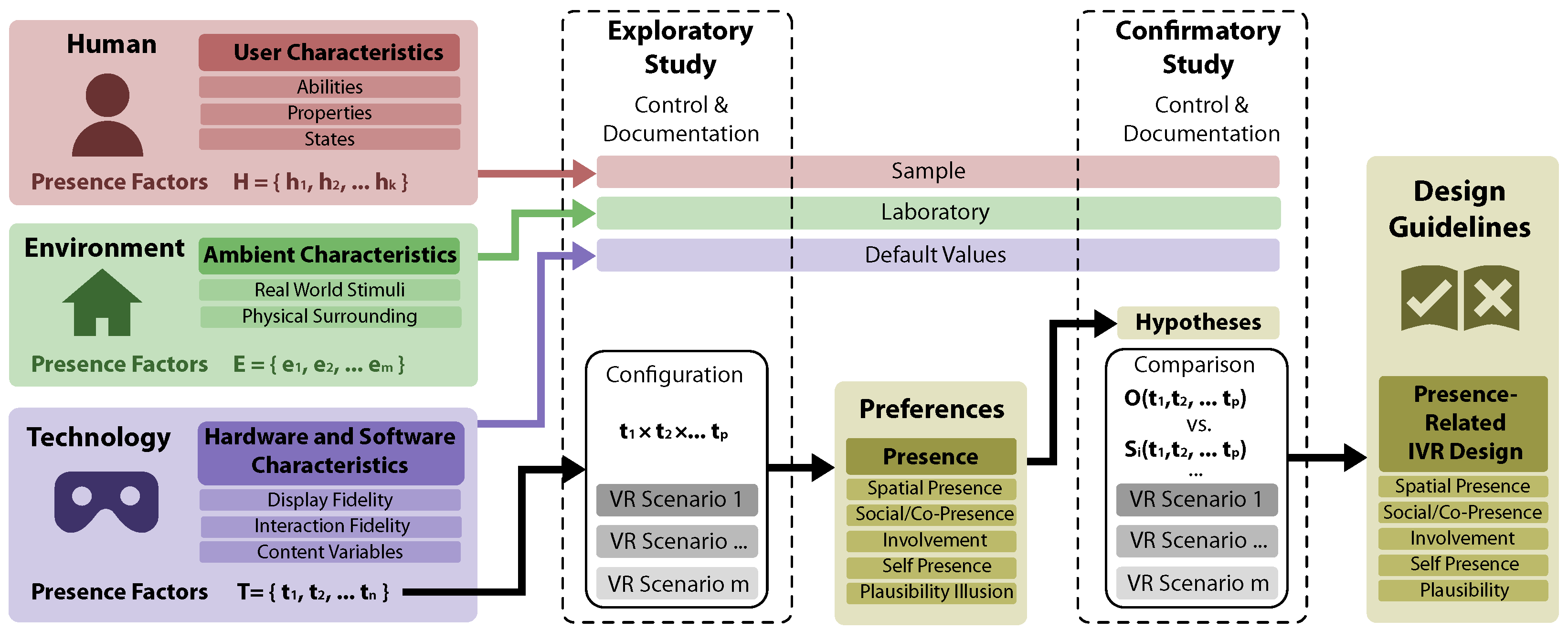
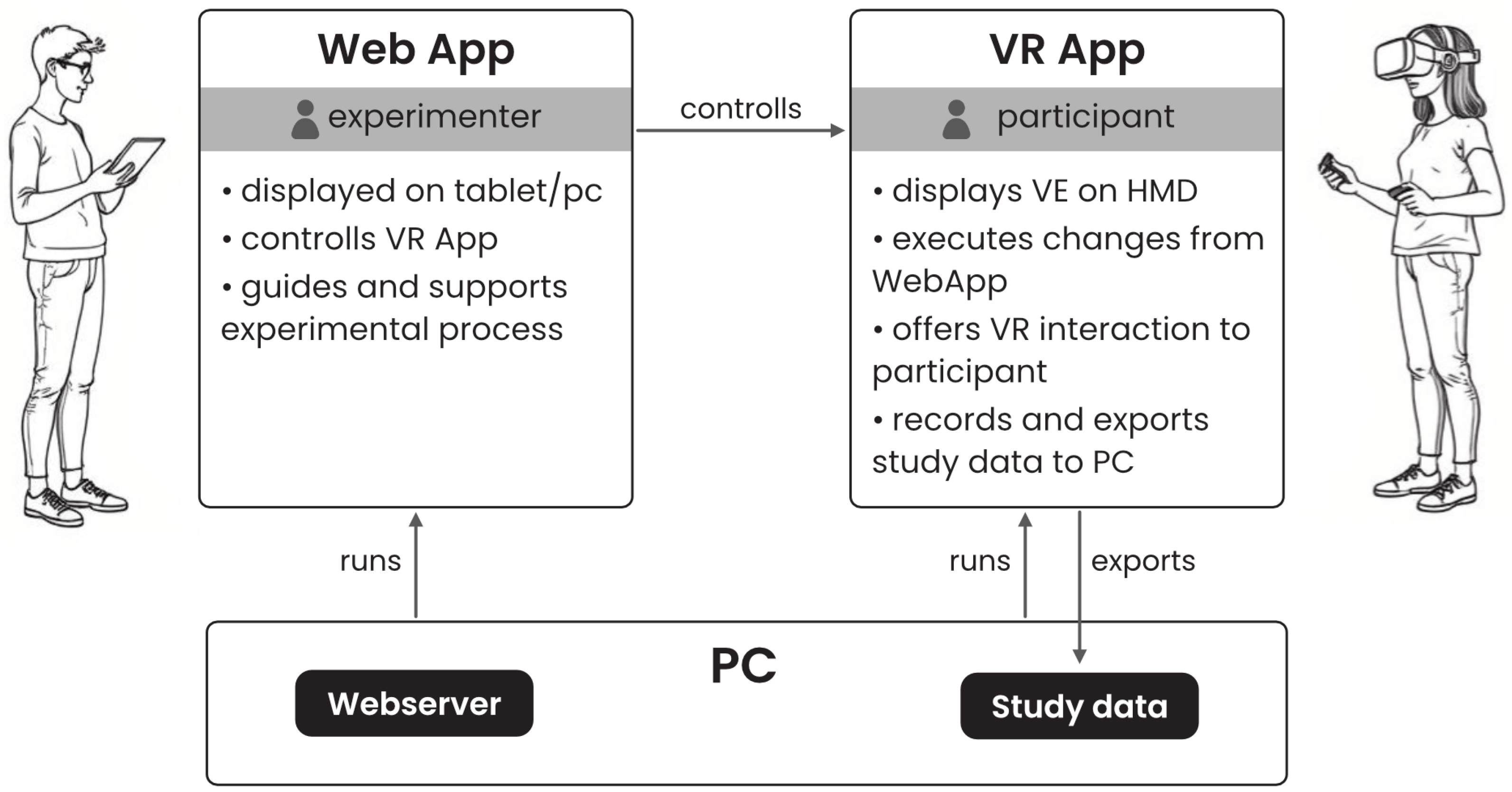



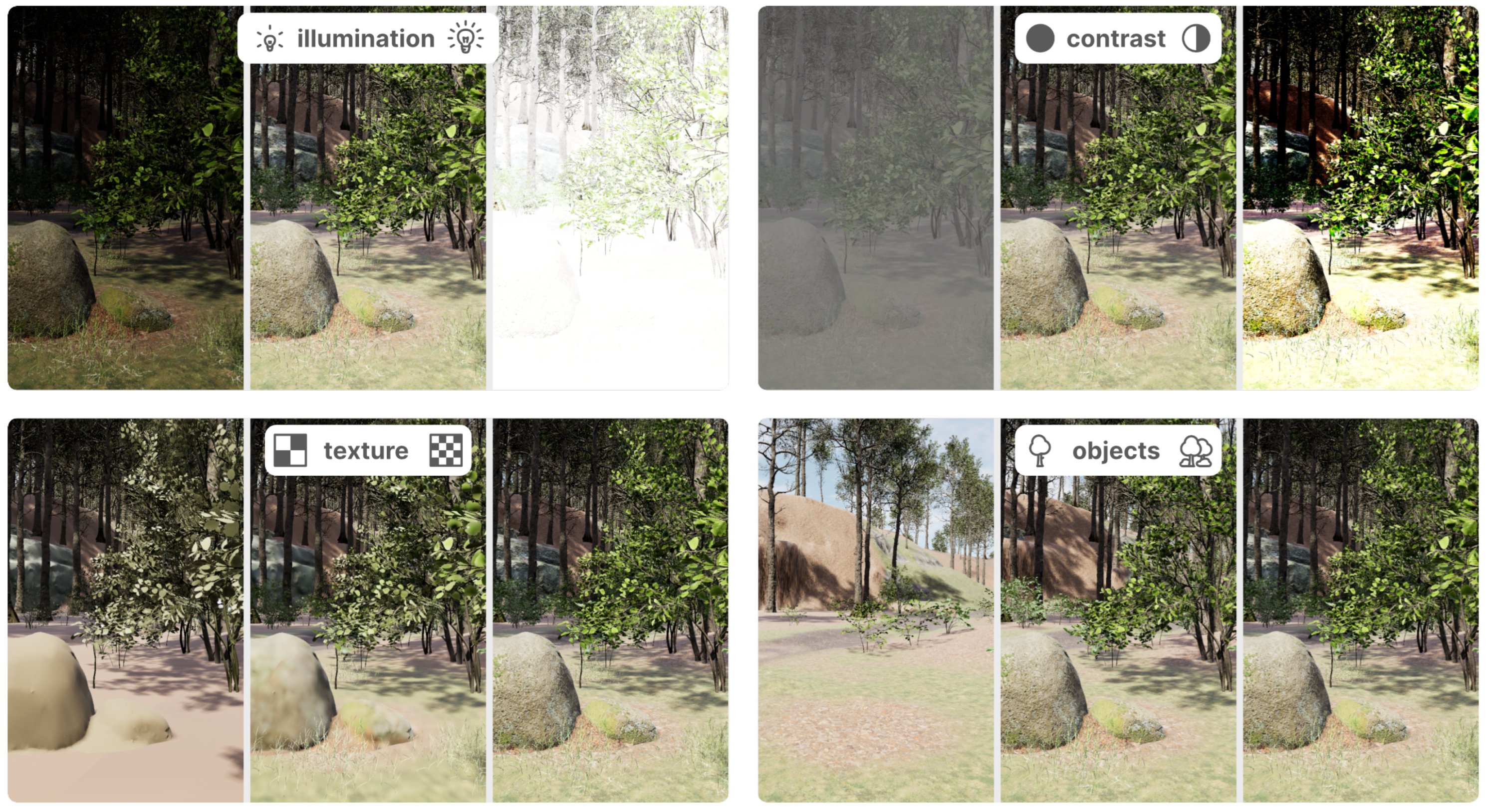

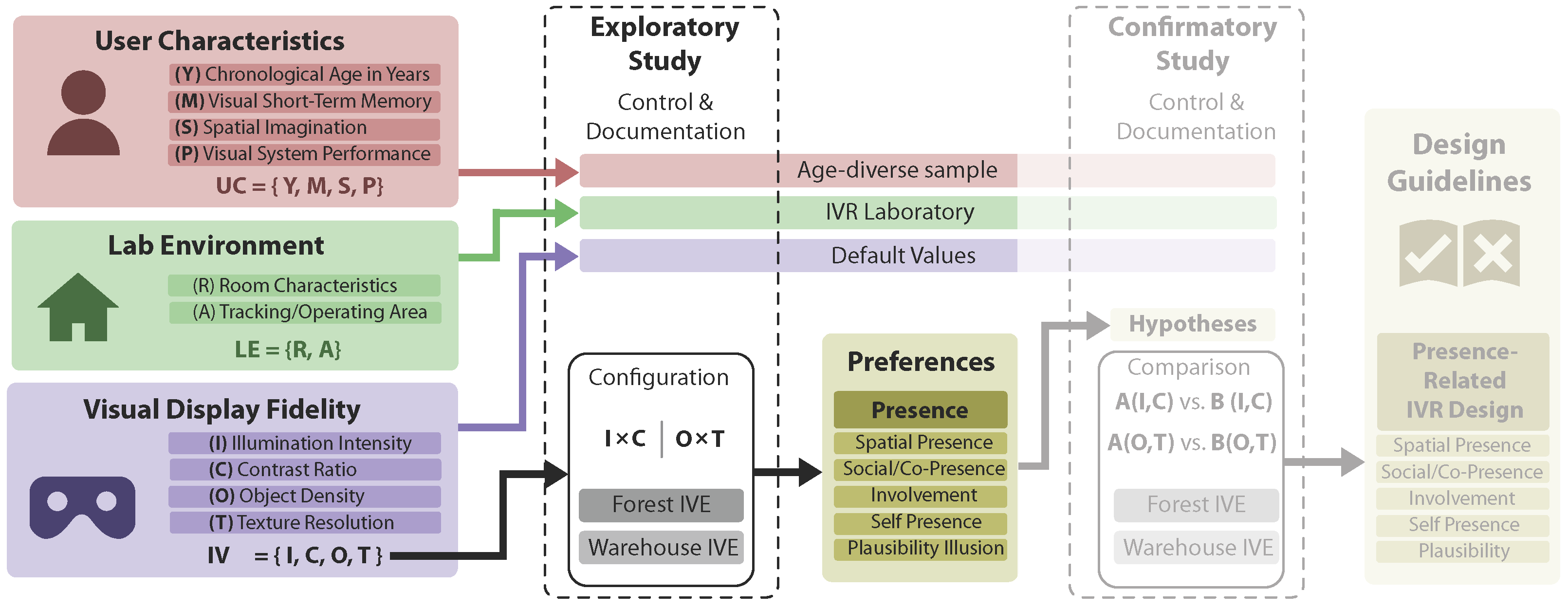
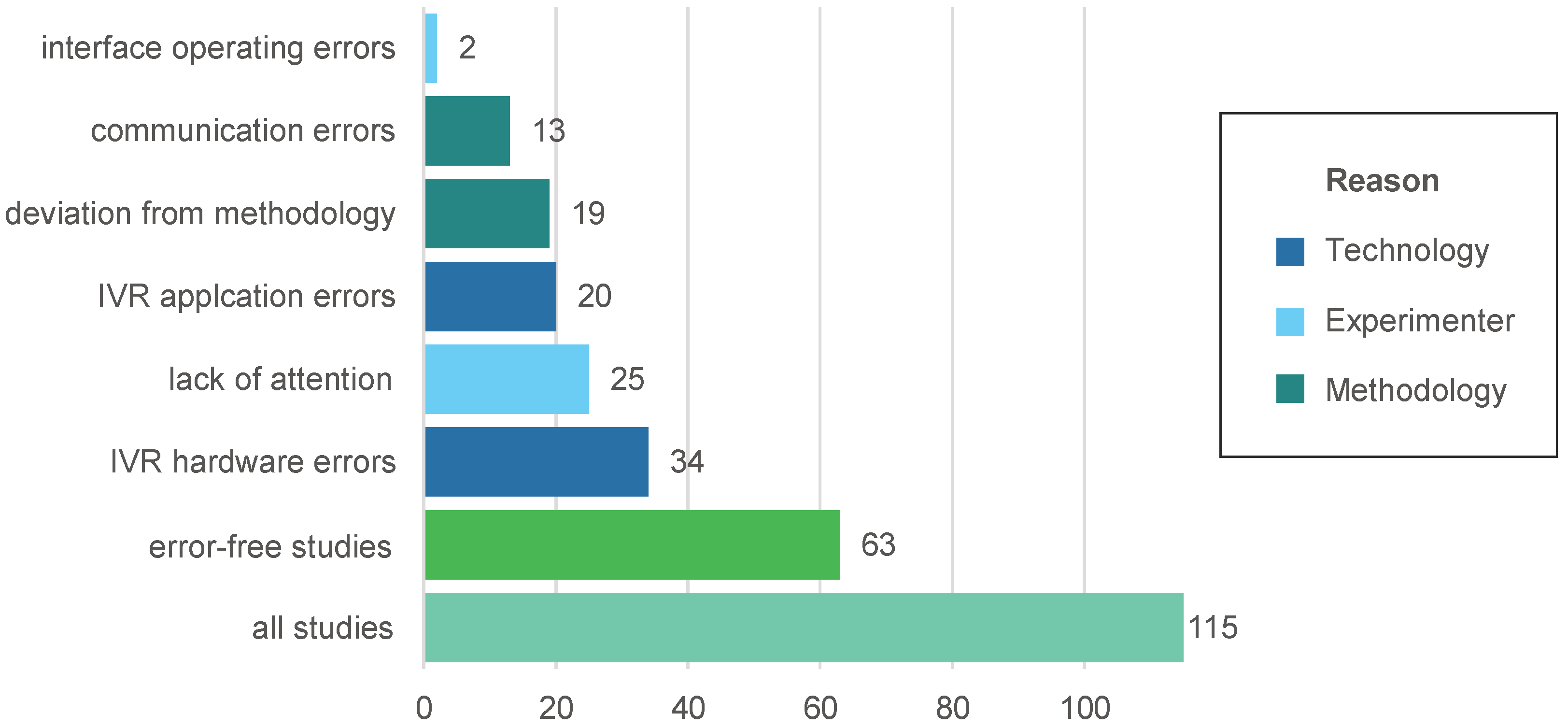

Disclaimer/Publisher’s Note: The statements, opinions and data contained in all publications are solely those of the individual author(s) and contributor(s) and not of MDPI and/or the editor(s). MDPI and/or the editor(s) disclaim responsibility for any injury to people or property resulting from any ideas, methods, instructions or products referred to in the content. |
© 2025 by the authors. Licensee MDPI, Basel, Switzerland. This article is an open access article distributed under the terms and conditions of the Creative Commons Attribution (CC BY) license (https://creativecommons.org/licenses/by/4.0/).
Share and Cite
Dresel, M.; Wortmann, R.B.; Siraf, P.; Fuchs, L.; Jochems, N. Enabling Exploratory Yet Systematic Investigation of Presence Factors in Virtual Reality: Proposed Methodology, Research Tool Development, and Practical Application. Virtual Worlds 2025, 4, 24. https://doi.org/10.3390/virtualworlds4020024
Dresel M, Wortmann RB, Siraf P, Fuchs L, Jochems N. Enabling Exploratory Yet Systematic Investigation of Presence Factors in Virtual Reality: Proposed Methodology, Research Tool Development, and Practical Application. Virtual Worlds. 2025; 4(2):24. https://doi.org/10.3390/virtualworlds4020024
Chicago/Turabian StyleDresel, Markus, Rafael Bennet Wortmann, Paul Siraf, Lennart Fuchs, and Nicole Jochems. 2025. "Enabling Exploratory Yet Systematic Investigation of Presence Factors in Virtual Reality: Proposed Methodology, Research Tool Development, and Practical Application" Virtual Worlds 4, no. 2: 24. https://doi.org/10.3390/virtualworlds4020024
APA StyleDresel, M., Wortmann, R. B., Siraf, P., Fuchs, L., & Jochems, N. (2025). Enabling Exploratory Yet Systematic Investigation of Presence Factors in Virtual Reality: Proposed Methodology, Research Tool Development, and Practical Application. Virtual Worlds, 4(2), 24. https://doi.org/10.3390/virtualworlds4020024






